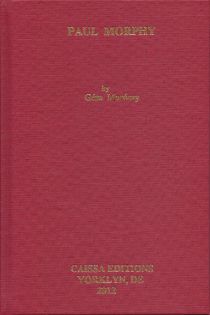Paul Morphy
Géza Maróczy

A new, extremely fine book by Caissa Editions is Sherwoods translation from German of Paul Morphy by Géza Maróczy. Maróczys 1909 work is a joy to read, full of quaint romantic prose by a modest author who was among the worlds top-10 players for well over a decade. Maroczy is charmingly in awe of his subject, almost starstruck. The Foreword begins:
Paul Morphy! A name with a wondrous, magical sound! It evokes the memory of the most outstanding master of all time and spurs the hearts of all chess devotees to beat faster, for every friend of the royal game admires and reveres him.
The beauty and depth of play of the noble-thinking, great master, the genius inherent in his ideas and plans, are without peer in the annals of chess. In this lies the reason why interest in Paul Morphy the chess hero remains as alive in the widest circles of chess devotees today as it did fifty years ago. And with good reason!
And two pages later:
Like a brilliant meteor, he appeared in the heavens of the chess world, quickly vanishing, but leaving behind an eternal remembrance. He was the Only, the Unique, with whom no one could compare. A personage in a realm of strict rules!
Okay, its a bit much, but wheres the harm? There is enough sober narrative to accompany this enthusiasm, and Maroczy is careful to record the literal course of Morphys career as he goes along. Still, passages such as the following one, describing the Café de la Régence, are particularly enjoyable:
Here, too, was where he conducted his most extraordinary achievements in blindfold play. The 27th of September, 1858, was the date of this monumental feat, requiring acute sharpness of memory and a far-reaching talent for calculation. When the result six wins and two draws became known to the feverishly excited throngs, thunderous applause burst through the wide halls such as had not been heard within these weathered walls since the time of Philidor. It was with a well-nigh awe-struck reverence that those present looked upon the young conqueror, for whom a precious gift of the highest chess talent had been bestowed from the cradle; and all present were taken with the conviction that there was no one among their contemporaries who had the power to wrestle this strongest of strong players to the ground.
Maroczys admiration extends beyond the board; he consistently points to Morphys gentle and honourable character as well as his obvious gifts as a player.
You should be aware, however, that this is still primarily a games collection, and not a prose narrative. Biographical material and general comments are limited, and the great bulk of the book is devoted to Maroczys annotation of Morphys games (407 of them, including some fragments). So to get the most out of this book, you need to plunge into the games there are ample diagrams, and its possible to do that without a board.
In conclusion, this is a fine book and a must for lovers of chess history. It is also a valuable collectors item, with a one-time print run of only 600 copies.
